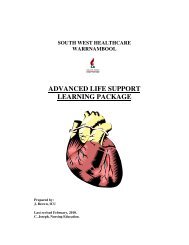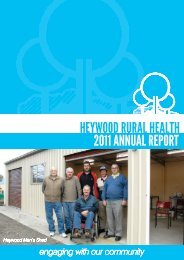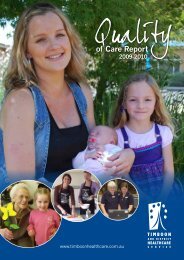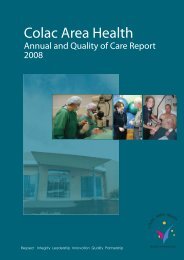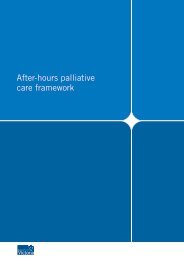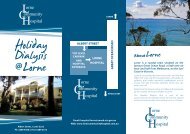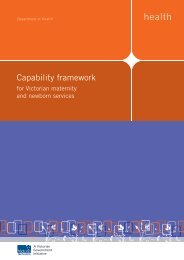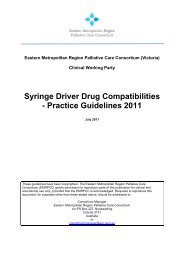Self Directed Learning Package - University of Queensland
Self Directed Learning Package - University of Queensland
Self Directed Learning Package - University of Queensland
- No tags were found...
Create successful ePaper yourself
Turn your PDF publications into a flip-book with our unique Google optimized e-Paper software.
126 • The Palliative Approach ToolkitSayReport your assessmentAs a careworker you play a critical role in reportingresident’s symptoms to the nursing staff.Thinking PointConsider the following scenario: You are walking withBob to the dining room and he is breathing quicklyand having trouble catching his breath, particularlywhen he speaks. He says he’s been feeling verybreathless for a few days.How would you report this to the nurse?Try and provide as much information as possible when reportingto the nurse. This will allow them to decide how urgently theyneed to review the resident.Thinking PointWhich <strong>of</strong> the following would be most effective?Careworker to nurse:‘Bob appears to be short <strong>of</strong> breath. He cannot walk tothe dining room without having to stop twice to catchhis breath. He says it has been a problem for a fewdays now’.Is much better than:‘Bob cant breath properly, please come and reviewhim’.Key PointSometimes it is an emergencyCall a nurse immediately if the resident hasdyspnoea and:• it is rated as (or appears) severe, or• it prevents the resident from talking, or• the resident also has chest pain, or• their skin is pale or cyanosed (i.e. blue tinge tothe fingers, lips or tongue).DoManage the symptomThinking PointConsider the following scenario:Bob becomes breathless whenever he has a shower.Usually he has to sit and rest for an hour or moreafterwards before he feels well enough to carry onwith his daily activities.As a careworker what can you do to help Bob managehis breathlessness from showering?Key PointResidents with dyspnoea benefit from havinga preventative plan <strong>of</strong> care. That is, we usemanagement strategies to prevent the onset, orreduce the impact <strong>of</strong>, the anxiety and distress <strong>of</strong>dyspnoea.Here are some examples:• Try not to rush or hurry Bob and allow rest periods duringactivities. This will decrease his need for oxygen and reducehis anxiety levels.• To prevent feelings <strong>of</strong> claustrophobia in the bathroom, leavethe exhaust fan switched on and make sure the shower wateris deflected away from Bob’s face.• When Bob returns to his room, sit him upright in a chair,perhaps leaning with his arms over a table or over-way table.This will open up his chest and lung space to allow in more air.• To create a sensation <strong>of</strong> moving air, open a window or use afan to circulate air.



